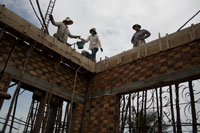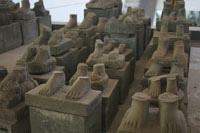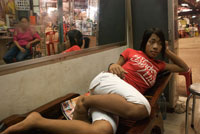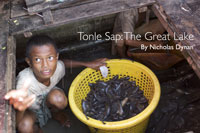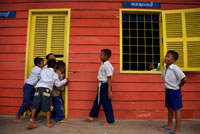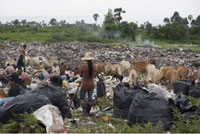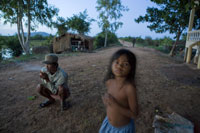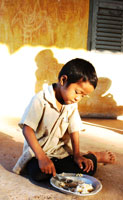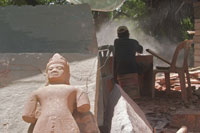Cambodia | Summer 2008
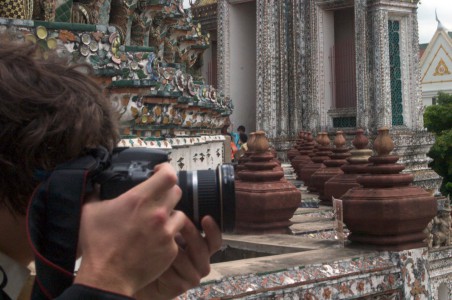
|
|
EXPOSURE-VII workshop in Cambodia | Summer 2008
The 2008 Cambodia Workshop is being jointly run through the mentorship of Gary Knight, founding member of VII Photo Agency, and Mort Rosenblum, former editor of the International Herald Tribune and long-time AP correspondent. This workshop is the fourth Knight and Rosenblum will have led together. During the seven days of the workshop, ten Tufts and School of the Museum of Fine Arts students will be actively following a documentary story through visual and written means, and receiving feedback on their work from Mr. Knight and Mr. Rosenblum. At the end of the workshop, participants will be expected to have completed an edited written piece and final selection of images.
Jess Bidgood | A Symbiotic Collision: Modern leisure and village tradition in Angkor CityThis is Siem Reap, Cambodia, a bustling, funky city that arises out of hundred of miles of rice fields and villages on the northern edge of lake Tonle Sap. It is home to Angkor Wat, an expansive temple complex built in the early 12th century by the ancient Khmer civilization, that has been a central point 2000 years of regional power struggles, religious conversion, imperialism, and the Khmer Rouge regime. Siem Reap, then, has long been at the pulse of Cambodian political and cultural development. Today, it is the source and the center of a cultural and economic explosion; the increased stability that followed the death of Pol Pot brought a 2500% increase in tourism to Siem Reap between 1998 and 2007. In this project, I explore the economic culture of a city has become a training ground for the development of a scarred country, an atomized city populated by a warmly fierce people that represents both Cambodia’s coming to terms with the struggles of its past and the possibilities of its future.
View Slideshow (coming soon)
Kyle Chayka | Reviving Heaven: The Preservation of AngkorSiem Reap, in the North of Cambodia, is a city with a surfeit of history.
Before the Khmer Rouge, before the French, there was the civilization of Angkor, at its height over 700 years ago. Remembered the world over for the construction of Angkor Wat, the largest religious monument on Earth, Angkor still persists in the Cambodian identity. It lives on in the scarred stone faces of the Buddha figures crowding the walls of Angkor’s temples, today massive tourists attractions. Angkor lives on in the headless sculptures, victims of looting, forever standing guard in a storehouse rarely visited by foreigners. Yet for all its omnipresence, Angkor is still in danger of being entombed by the past, its temples toppled by looters and trampled by tourists. Through reconstruction, preservation, the opening of a brand new art museum, and the work of thousands of dedicated individuals, Cambodians have found a path to preserve both the history as well as the living reality of Angkor while leaving the wonder of the place itself intact.
Alison Coffey | Katoey: The Margins of Cambodian ToleranceBeneath a widespread tolerance in Cambodian society lays a world of exclusion for the country’s katoey, or transgender, population. Barred from many establishments and facing verbal and physical abuse at the hands of the police, discrimination has increased in recent years and daily life is filled with uncertainty as their incomes remain sporadic and arrests are more common.
Nick Dynan | Tonle Sap: The Great LakeAlong Tonle Sap Lake, villages dotting the shore survive upon a timeless tradition of fishing. Both a source of income and nourishment, the lake’s flowing water functions as vital lifeblood for millions within Cambodia. However, the lake’s ecological and economic wealth has come under threat from a myriad of sources. Increases in population, upstream damming, deforestation, pesticides, and extensive overfishing are threatening the future of the water system. While structures have been implemented in order to curb these hazards, they face their own internal challenges, ones that must be alleviated if the prosperous future of the lake is to be ensured.
Elizabeth Herman | Education for All?In June 2008, Elizabeth traveled to Siem Reap, Cambodia with nine other students on an EXPOSURE / VII Photo Agency run photojournalism workshop. Under the guidance of Gary Knight and Mort Rosemblum, she spent a week in Siem Reap and the neighboring villages, attempting to address issues of youth education and employment, examining enrollment rates, family pressures, and the effect of the government on schooling. "Education for All?" focuses on the story she covered there, as well as a few standout experiences from the field.
View Slideshow (coming soon)
Jessica Hutfless | Landmines and Disabilities in Siem Reap
Sarah Jacobson | “Fly” Village: Waste in Siem ReapPreikuy, a village about 10 miles outside of Siem Reap, Cambodia, is the dumping ground for the tourist town’s solid waste. With virtually no municipal waste infrastructure, the town has been placing waste in the middle of the village for almost ten years. Over two million travelers yearly and 100,000 residents contribute to the 25 acre landfill. The issue with solid waste in Siem Reap illustrates the global issue with waste – where should it go? This issue, among other effects of globalization, contribute to the changing face of village life in Cambodia.
View Slideshow (coming soon)
Nicki Sobecki | A Khmer Prognosis: Health in CambodiaTo some, Cambodia is a success story in the global landscape of AIDS, bringing the rate of infection down from its peak of 3 percent in 1997 to an infection rate of 0.9 percent. Despite this dramatic decline, however, Cambodia still has the highest rate of HIV in Southeast Asia and one of the highest in Asia, and it risks coming back. The current conditions of Cambodia's primary healthcare system are severely overstretched and the endemic and has led to thousands of impoverished Cambodians having no access to healthcare. In many cases local hospitals charge for treatment so that they can pay salaries and maintain an electrical supply.
View Slideshow (coming soon)
Clement Tan | A Reporter's EpiphanyAfter a fruitless first few days of the workshop in Siem Reap, Clement Tan stumbles on a journalistic minefield when he followed the United Nations Food Program out into rural Cambodia. Talking to ordinary Cambodians and taking pictures wherever he went, he realizes these are stories of a marginalized people that needs to be told. While this is ostensibly the story documenting the impact of rising food prices on one of the poorest societies in the world, it is This also story of the everything that inspired a professional epiphany in the outskirts of Siem Reap Province.
View Slideshow
Benjamin Taylor | The Economics of Khmer HeritageCambodian culture, at all levels of society, has always rotated around what is seen as the glory of its ancient civilization. The genocide at the hands of the Khmer Rouge in the 1970s decimated knowledge of Cambodia's heritage and severed nearly all links to the past. The city of Siem Reap, though, has weaned opportunities for the revitalization of Khmer culture out of the ever-increasing tourist interest in the nearby temple complex of Angkor Wat. Gradually but determinedly, workshops and institutions have sprung up to revive ancient practices of stone carving and to reestablish links between art and community-centered Buddhist life. Much of the activity naturally caters to the fleeting attention of tourists, and most of the artwork one encounters in Siem Reap consists of watered-down facsimiles of Angkor's imagery. The national government has provided little support to any cultural initiative other than ones ostentatious enough to attract tourism. Local entrepreneurs and self-trained artists, though, are taking it upon themselves to reinstate a creative heritage using what resources and free time they have. Even the modest increase in opportunity that an expanding economy has allowed them is enough to foster their engagement.
 Jess Bidgood is a sophomore attempting to double-major in International Relations and Philosophy while minoring in English. She has been a member of Exposure since she was a freshman, and participated in the Kashmir workshop trip in August 2007. She is also a member of the 2008 EPIIC colloquium on Global Poverty and Inequality, which brought her to Lima over the winter inter-session to look at the linkages between top-down and community-centered approaches to urban development. On campus, she pursues her interests in writing, politics, and art through active participation in the Tufts Democrats, as editor for the Tufts Daily and the IGL's Discourse, and, occasionally, as an actress in 3P's theater productions. Jess Bidgood is a sophomore attempting to double-major in International Relations and Philosophy while minoring in English. She has been a member of Exposure since she was a freshman, and participated in the Kashmir workshop trip in August 2007. She is also a member of the 2008 EPIIC colloquium on Global Poverty and Inequality, which brought her to Lima over the winter inter-session to look at the linkages between top-down and community-centered approaches to urban development. On campus, she pursues her interests in writing, politics, and art through active participation in the Tufts Democrats, as editor for the Tufts Daily and the IGL's Discourse, and, occasionally, as an actress in 3P's theater productions. |
 Kyle Chayka is a sophomore at Tufts majoring in International Relations and Art History. He is interested in the intersection of visual arts and cultural exchange, the creation of identity and its expression through art. Kyle also works in the Contemporary Art department of the Boston Museum of Fine Arts. His international relations studies focus on the regional politics of Asia, with a specific focus on the influence of China, which he hopes to pursue in Cambodia. Kyle is currently the visual arts editor for the Tufts Daily newspaper and continues with his own art on the side. Kyle Chayka is a sophomore at Tufts majoring in International Relations and Art History. He is interested in the intersection of visual arts and cultural exchange, the creation of identity and its expression through art. Kyle also works in the Contemporary Art department of the Boston Museum of Fine Arts. His international relations studies focus on the regional politics of Asia, with a specific focus on the influence of China, which he hopes to pursue in Cambodia. Kyle is currently the visual arts editor for the Tufts Daily newspaper and continues with his own art on the side. |
 Alison Coffey is a freshman at Tufts planning to major in anthropology and interested in urban migration and housing issues. Her passion for both human rights and photography led to her to Exposure, in which she has been involved since her arrival at Tufts. She is excited for the opportunity to travel to Cambodia and further explore photojournalism as a tool for creating change. Alison Coffey is a freshman at Tufts planning to major in anthropology and interested in urban migration and housing issues. Her passion for both human rights and photography led to her to Exposure, in which she has been involved since her arrival at Tufts. She is excited for the opportunity to travel to Cambodia and further explore photojournalism as a tool for creating change. |
 Nicholas Dynan is a freshman at Tufts University and a member of the Combined Degree Program with the School of Museum of Fine Art. He is a first year member of Exposure and has been involved in Technical Workshops for Exposure members. He recently photographed at the EPIIC symposium. Nick has photographed through out high school and has recently become involved in photojournalism due to a growing interest in current events. Nicholas Dynan is a freshman at Tufts University and a member of the Combined Degree Program with the School of Museum of Fine Art. He is a first year member of Exposure and has been involved in Technical Workshops for Exposure members. He recently photographed at the EPIIC symposium. Nick has photographed through out high school and has recently become involved in photojournalism due to a growing interest in current events. |
 Laura Gilbert is a freshman. She is studying anything and everything—with a slight emphasis on Community Health and Comparative Religion—in the hope that something will truly grab her by the time she needs to make her majoring decision. She got into photography in high school, but did not start considering it a hobby until she traveled to East Africa in the summer of 2006 and became one with her camera. She is specifically interested in photojournalism as she sees it as a practical application of photography for social change. She has been involved with Exposure since her first week of freshman year. She hopes to gain a greater understanding both of photography and journalistic writing on the trip, in additiition to some great times and a definite love for all things Cambodia. Laura Gilbert is a freshman. She is studying anything and everything—with a slight emphasis on Community Health and Comparative Religion—in the hope that something will truly grab her by the time she needs to make her majoring decision. She got into photography in high school, but did not start considering it a hobby until she traveled to East Africa in the summer of 2006 and became one with her camera. She is specifically interested in photojournalism as she sees it as a practical application of photography for social change. She has been involved with Exposure since her first week of freshman year. She hopes to gain a greater understanding both of photography and journalistic writing on the trip, in additiition to some great times and a definite love for all things Cambodia. |
 Elizabeth Herman is a sophomore majoring in Economics and minoring in Political Science at Tufts University. After taking darkroom photography in high school for four years she came to college looking for a way to apply those skills, came across EXPOSURE, and immediately became interested in the group's work. She participated in the Institute for Global Leadership's EPIIC colloquium this year, which focused on Global Poverty and Inequality. Her academic interests include such varied topics as development economics, marginalization and inclusion through education, and human rights. Elizabeth Herman is a sophomore majoring in Economics and minoring in Political Science at Tufts University. After taking darkroom photography in high school for four years she came to college looking for a way to apply those skills, came across EXPOSURE, and immediately became interested in the group's work. She participated in the Institute for Global Leadership's EPIIC colloquium this year, which focused on Global Poverty and Inequality. Her academic interests include such varied topics as development economics, marginalization and inclusion through education, and human rights. |
 Jessica Hutfless is a graduate student in the Masters of Fine Arts program at the School of the Museum of Fine Arts, Boston, in affilitation with Tufts University. She is from Napa, California, and earned her BA at the University of California, Berkeley studying History and Art Practice. She has traveled extensively, has worked at National Geographic, The Center for Strategic and International Studies, and as an assistant to several Photographers. Jessica currently studies photography and printmaking. Jessica Hutfless is a graduate student in the Masters of Fine Arts program at the School of the Museum of Fine Arts, Boston, in affilitation with Tufts University. She is from Napa, California, and earned her BA at the University of California, Berkeley studying History and Art Practice. She has traveled extensively, has worked at National Geographic, The Center for Strategic and International Studies, and as an assistant to several Photographers. Jessica currently studies photography and printmaking. |
 Sarah Jacobson is a senior at Tufts University majoring in English and Fine Arts. Hailing from Whitefish Bay, Wisconsin, she has enjoyed her four years in Boston immensely. Of her varied interests, she is most passionate about painting and music. She participated in the EPIIC 2005-2006 Colloquium, Politics of Fear. After participating in the photojournalism project in Buenos Aires and spending a semester in Senegal, she is interested in the role that photography and visual art can play at empowering individuals and creating a more unified global society. Sarah Jacobson is a senior at Tufts University majoring in English and Fine Arts. Hailing from Whitefish Bay, Wisconsin, she has enjoyed her four years in Boston immensely. Of her varied interests, she is most passionate about painting and music. She participated in the EPIIC 2005-2006 Colloquium, Politics of Fear. After participating in the photojournalism project in Buenos Aires and spending a semester in Senegal, she is interested in the role that photography and visual art can play at empowering individuals and creating a more unified global society. |
 Nicki Sobecki is a senior Political Science major at Tufts University. Through her participation in Exposure, Nicki has had the opportunity to intern for photojournalist James Nachtwey, participate in a journalism workshop in Kosovo, and work with Jim MacMillian on a workshop examining the effects of gun violence in Philadelphia, a project she has continued over the past two years as a documentary film entitled "The Luckiest Man: Gun Violence in Urban America." Through Nicki's EPIIC research she travelled with the Amahoro Project to Rwanda to document the reconstruction efforts. Last Spring Nicki interned for the Daily Star newspaper in Beirut, Lebanon and participated in the NIMEP fact-finding mission to Lebanon. This past summer she was privileged to participate in the World Crew program of the Jacob Burns Film Center where she filmed a documentary entitled "Shooting for Peace," which explores several grassroots initiatives to reach people affected by AIDS, unsanitary water conditions, and civil war. Nicki enjoys her coffee black and makes a mean paella. Nicki Sobecki is a senior Political Science major at Tufts University. Through her participation in Exposure, Nicki has had the opportunity to intern for photojournalist James Nachtwey, participate in a journalism workshop in Kosovo, and work with Jim MacMillian on a workshop examining the effects of gun violence in Philadelphia, a project she has continued over the past two years as a documentary film entitled "The Luckiest Man: Gun Violence in Urban America." Through Nicki's EPIIC research she travelled with the Amahoro Project to Rwanda to document the reconstruction efforts. Last Spring Nicki interned for the Daily Star newspaper in Beirut, Lebanon and participated in the NIMEP fact-finding mission to Lebanon. This past summer she was privileged to participate in the World Crew program of the Jacob Burns Film Center where she filmed a documentary entitled "Shooting for Peace," which explores several grassroots initiatives to reach people affected by AIDS, unsanitary water conditions, and civil war. Nicki enjoys her coffee black and makes a mean paella. |
 Ben Taylor is a freshman and a prospective English and Peace & Justice Studies major. He is primarily interested in fiction and creative non-fiction writing, and plans to study more in the field of communications and media studies. Since arriving at Tufts in the fall he has contributed to The Daily and The Observer, along with pieces in arts publications, and has participated in general [EXPOSURE] meetings and activities. He hopes in the future to participate more broadly in the programs the IGL has to offer. In lieu of a specific focus for his role in the Cambodia workshop, he is eager to experience firsthand and document how the culture responds to living in a state of flux. He has always been drawn to photography and written journalism that honestly portrays harsh reality, seeking as much exposure as possible. Ben Taylor is a freshman and a prospective English and Peace & Justice Studies major. He is primarily interested in fiction and creative non-fiction writing, and plans to study more in the field of communications and media studies. Since arriving at Tufts in the fall he has contributed to The Daily and The Observer, along with pieces in arts publications, and has participated in general [EXPOSURE] meetings and activities. He hopes in the future to participate more broadly in the programs the IGL has to offer. In lieu of a specific focus for his role in the Cambodia workshop, he is eager to experience firsthand and document how the culture responds to living in a state of flux. He has always been drawn to photography and written journalism that honestly portrays harsh reality, seeking as much exposure as possible. |


